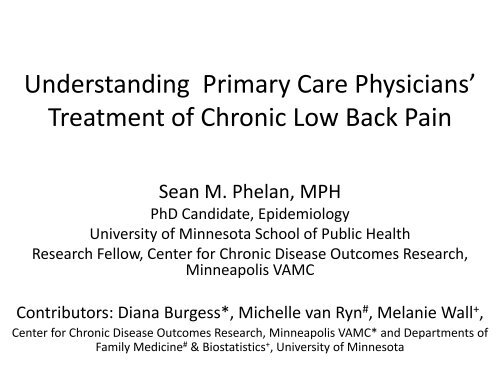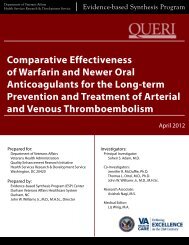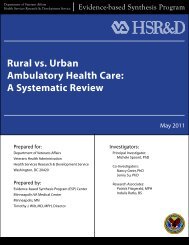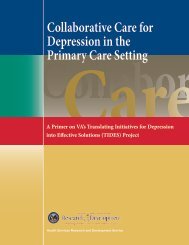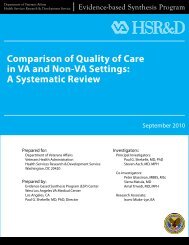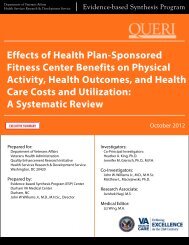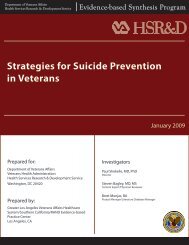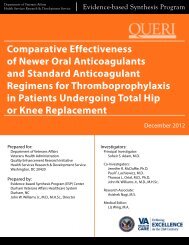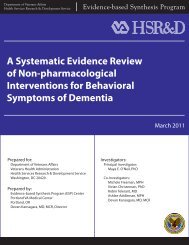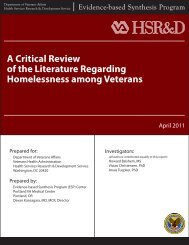Understanding Primary Care Physicians' Treatment of Chronic Low ...
Understanding Primary Care Physicians' Treatment of Chronic Low ...
Understanding Primary Care Physicians' Treatment of Chronic Low ...
Create successful ePaper yourself
Turn your PDF publications into a flip-book with our unique Google optimized e-Paper software.
<strong>Understanding</strong> <strong>Primary</strong> <strong>Care</strong> Physicians’<br />
<strong>Treatment</strong> <strong>of</strong> <strong>Chronic</strong> <strong>Low</strong> Back Pain<br />
Sean M. Phelan, MPH<br />
PhD Candidate, Epidemiology<br />
University <strong>of</strong> Minnesota School <strong>of</strong> Public Health<br />
Research Fellow, Center for <strong>Chronic</strong> Disease Outcomes Research,<br />
Minneapolis VAMC<br />
Contributors: Diana Burgess*, Michelle van Ryn # , Melanie Wall + ,<br />
Center for <strong>Chronic</strong> Disease Outcomes Research, Minneapolis VAMC* and Departments <strong>of</strong><br />
Family Medicine # & Biostatistics + , University <strong>of</strong> Minnesota
Purpose<br />
1. To empirically define classes <strong>of</strong> physicians<br />
according to their approach to treating<br />
uncontrolled chronic low back pain<br />
2. To identify physician characteristics, attitudes,<br />
& blif beliefs and practice characteristics ti that<br />
t<br />
predict class membership
<strong>Chronic</strong> Pain <strong>Treatment</strong><br />
• Prevalence <strong>of</strong> chronic non‐cancer pain high h and rising ii in<br />
VA.<br />
– In one study, ~60% <strong>of</strong> VA patients discharged between<br />
10/1/01 and 11/30/07 reported pain and 26% reported<br />
moderate to severe pain. (Haskell et al, 2009)<br />
– Much variability in physicians’ treatment decisions (Somerville,<br />
Hay et al 2008)<br />
– Lack <strong>of</strong> consensus on treatment despite VA and other<br />
organizations’ guidelines<br />
• VA/DoD Guidelines specify that opioids should be used<br />
VA/DoD Guidelines specify that opioids should be used<br />
when other pain therapies are inadequate
Historical Trends<br />
• Use <strong>of</strong> opioids to treat chronic pain increased through the<br />
1990’s<br />
– clinical community and regulatory boards more supportive <strong>of</strong> their use<br />
(Gilson & Joranson 2001)<br />
– compensation systems favored dbrief visits for medication management<br />
(Gallagher & Rosenthal 2008)<br />
– aggressive marketing (Olsen, Daumit, Ford 2006)<br />
• Use leveled <strong>of</strong>f in the 2000’s as concerns over tolerance,<br />
side‐effects, diversion, and dependence grew<br />
• More recently, use <strong>of</strong> opioid treatment has increased, but<br />
there remains wide variability in whether opioids are used.<br />
• Little is known about frequency <strong>of</strong> multimodal approach to<br />
treating chronic pain
Efficacy <strong>of</strong> Opioids for <strong>Chronic</strong> Pain<br />
• Recent meta‐analysis <strong>of</strong> studies <strong>of</strong> opioid<br />
efficacy for long‐term reduction in chronic noncancer<br />
pain found<br />
• significant reduction in pain across studies<br />
• signs <strong>of</strong> opioid addiction in only .05%, and abuse in<br />
only .43% <strong>of</strong> participants. p<br />
• However, 33% <strong>of</strong> participants p using oral opioids<br />
discontinued treatment due to side‐effects, and<br />
12% withdrew due to insufficient pain relief.<br />
(Noble et al 2008)
Efficacy <strong>of</strong> Psychological Therapies<br />
• Clinical ltrials provide evidence that Cognitive‐<br />
Behavioral Therapy reduces pain severity.<br />
(Glombiewski et al 2009, Morley et al 1999)<br />
• Maladaptive coping strategies like<br />
catastrophizing shown to increase pain severity,<br />
while cognitive strategies like imagery,<br />
distraction, and positive expectancy shown to<br />
reduce pain severity (Gatchel et al 2008)<br />
• Meta‐analysis <strong>of</strong> anti‐depressant therapy for<br />
chronic pain shows it reduces pain severity<br />
(Salerno et al 2002)
Social Factors and <strong>Chronic</strong> Pain<br />
• A number <strong>of</strong> social factors affect and are<br />
affected by pain.<br />
• Expectations based on previous medical<br />
treatment t tmay lead dto postponement t<strong>of</strong> care<br />
• Frustration over oerlack <strong>of</strong> relief or loss <strong>of</strong> ability to<br />
work may exacerbate perceived severity <strong>of</strong> pain<br />
• Relationships, social support, family functioning<br />
can greatly influence perceived severity <strong>of</strong> pain
Biopsychosocial Pain Model<br />
(Gatchel, et al 2007)<br />
Bio Psycho Social<br />
Central Processes<br />
Biological Cognitive<br />
Somatic Affective<br />
---------------------------------------------------------------------<br />
Efferent Feedback<br />
Afferent Feedback<br />
----------------------------------------------------------------------<br />
Peripheral Processes<br />
Autonomic Endocrine<br />
Immune Systems<br />
---------------------------------------------------------------------<br />
Genetic Predispositions<br />
Activities <strong>of</strong> Daily<br />
Living<br />
Environmental<br />
Stressors<br />
Relationships<br />
Family Functioning<br />
Social Support<br />
Isolation<br />
Cultural Factors<br />
Insurance<br />
Medical <strong>Treatment</strong><br />
History
Biopsychosocial model<br />
• Pain has physiological, psychological, and social<br />
components<br />
• Nociception i refers to nerve stimulus indicating<br />
i<br />
tissue damage<br />
• Pain refers to subjective perception that is<br />
influenced by:<br />
▫ genetic predisposition,<br />
▫ past experiences,<br />
▫ coping strategies,<br />
▫ psychological status, and<br />
▫ sociocultural background
Biopsychosocial model<br />
• Does not imply that pain is not real, rather that<br />
the complexity <strong>of</strong> the pain experience means<br />
that there are multiple causes <strong>of</strong> pain and areas<br />
<strong>of</strong> intervention.<br />
ti<br />
• Avocates a multimodal pain treatment focused<br />
on emotion, cognition, functioning, behavior as<br />
well as nociceptive dysregulation.
Current Study<br />
• The current study was designed to understand<br />
variations in pain treatment by physician,<br />
practice, and patient t factors.<br />
• Opportunity to apply latent variable technique<br />
to evaluate whether physicians are utilizing a<br />
multimodal approach to treat chronic<br />
nonmalignant pain<br />
• Measuring characteristics <strong>of</strong> physicians that do<br />
utilize a multimodal approach may inform<br />
future physician training
Methods
Photonovella<br />
• Bt Between‐subjects t design<br />
• Physicians randomly assigned to receive 1 <strong>of</strong> 24<br />
patient scenarios that varied by patient race,<br />
age, facial expression, and ‘red vs. green flag’<br />
dialogue (h (these factors are adjusted dfor in<br />
analysis)<br />
• Patient ‘clinic note’ history identical<br />
– Identified patient as veteran<br />
• Four images <strong>of</strong> patient in a clinical setting<br />
accompanied idby dialogue
Clinic Note<br />
A 45‐year old male patient with complaint <strong>of</strong> severe intermittent low back pain for 6<br />
months. The patient noted the onset <strong>of</strong> pain after lifting a heavy box 1 year ago. The<br />
pain has been increasing in intensity over the past few months.<br />
He reports that his previous primary care physician prescribed naproxen, but this caused<br />
reflux symptoms and was subsequently discontinued. He tried physical therapy but<br />
this made the pain worse, so he stopped going. He has been tki taking extra strength<br />
th<br />
Tylenol 2 tablets bid with no improvement in the pain.<br />
He gives a history <strong>of</strong> drinking heavily in the military but reports that he currently only<br />
drinks 1‐2 beers every other week. No history <strong>of</strong> illicit drug use.<br />
His old medical records are currently not available.<br />
On physical exam, he appears in moderate pain when moving on and <strong>of</strong>f the exam table.<br />
Spine is normally aligned. No focal tenderness over the lumbar spine but lumbar<br />
paraspinal muscles are mildly tender to palpation bilaterally. Forward flexion <strong>of</strong> the<br />
lumbar spine is limited to 60 degrees by pain. Gait is stable but slow due to pain.<br />
<strong>Low</strong>er extremity strength is 5/5 bilaterally and deep tendon reflexes are +2 bilaterally.<br />
Straight leg raise is negative bilaterally.<br />
Lumbar spine x‐rays are normal.
Images from Questionnaire
Dialogue<br />
1. Doctor: So, what’s going on<br />
today? What brings you in?<br />
Patient: This pain in my back<br />
again, it’s pretty bad.<br />
3. Doctor: Are you able to do<br />
your usual activities? Go to<br />
work, sleep, that sort <strong>of</strong> thing?<br />
Patient: Well, I do my job, <strong>of</strong><br />
course, I do what I have to do.<br />
I’ve had to miss a few weeks,<br />
though. It does bother me some<br />
at night when I’mtryingto<br />
to<br />
sleep, I’ve got to admit.<br />
2. Doctor: When do you have the pain?<br />
Patient: Well, it’s pretty much with me all<br />
the time, I guess.<br />
4. Doctor: Well, your physical exam<br />
doesn’t show anything abnormal or new<br />
from last time. What have you tried for it?<br />
Patient: Not much really, I don’t like to<br />
take anything. I tried that Tylenol 3 you<br />
gave me a couple times, but that’s about it.<br />
It helped right after but it didn’t last long.<br />
Maybe I should try something else.<br />
Doctor: Have you tried physical therapy?<br />
Patient: I went to physical therapy a<br />
couple <strong>of</strong> times, but it actually made the<br />
pain worse.
Sample<br />
• Questionnaires sent to national sample <strong>of</strong><br />
1000 general internal medicine doctors drawn<br />
randomly within region from the AMA<br />
Masterfile<br />
• 953 were delivered to known addresses<br />
• 382 (40%) were returned<br />
– 30% female<br />
– Average Age = 45; SD=12<br />
– 58% white; 22% Asian/PI; 7% Latino/Hispanic; 5% Black;<br />
4% Southwest Asian/Indian; 5% Other race
Outcome Measure<br />
Please indicate how likely you would be to take each <strong>of</strong> the<br />
following actions with this patient…<br />
1. Discuss emotional issues and their possible<br />
contribution to pain?<br />
2. Order further diagnostic testing?<br />
3. Perform functional assessment?<br />
4. Rf Refer for physical lth therapy?<br />
5. Refer for mental health evaluation?<br />
6. Refer to a pain clinic or specialist if available?<br />
7. Further question patient about drugs and alcohol?
Outcome Measure<br />
Please indicate how likely you would be to take each <strong>of</strong> the<br />
following actions with this patient…<br />
8. Instruct patient to take the Tylenol 3 more regularly and<br />
at a higher dose?<br />
9. Change patient’s treatment to a different schedule 3<br />
opioid?<br />
10. Treat this patient with a short‐acting Schedule 2 opioid<br />
(such as Dilaudid or Percocet) on an as‐needed basis?<br />
11. Treat with a long‐acting Schedule 2 opioid (such as<br />
Fentanyl Patch, Oxycontin, methadone, or sustained‐<br />
release morphine) on a fixed around‐the‐clock kbasis?
Latent Class Analysis<br />
• Multivariate data reduction technique<br />
• Indicator variables relate to a latent construct‐a<br />
variable that is not directly observable<br />
• Can be thought <strong>of</strong> as factor analysis applied to<br />
categorical indicators that results in a<br />
categorical latent variable (classification <strong>of</strong><br />
people).
Latent Class Analysis<br />
• Creates categories based on posterior<br />
probability <strong>of</strong> a certain response to an indicator<br />
item, given membership in a particular class.<br />
• Conditional Independence: If we could<br />
condition on the latent class variable, the<br />
observed indicator variables would be<br />
independent<br />
– In other words, each individual’s latent class<br />
category is the underlying cause <strong>of</strong> all observed<br />
associations iti
LCA<br />
different schedule 3 opioid<br />
short acting schedule 2 opioid<br />
long-acting schedule 2 opioid<br />
Tylenol 3 more regularly<br />
Patient Expression<br />
Patient Age<br />
Patient Race<br />
Patient Dialogue<br />
Latent <strong>Treatment</strong><br />
Class<br />
(<strong>Treatment</strong> Style)<br />
Order further diagnostic testing<br />
Perform functional assessment<br />
Refer for physical therapy<br />
Refer for mental health evaluation<br />
Refer to a pain clinic<br />
Discuss emotional issues<br />
Question about drugs and alcohol
LCA Model Selection<br />
• We considered a 2,3,4,5,and 6‐latent class solution.<br />
• The 3‐class model had superior sample‐size adjusted<br />
Bayesian Information Criterion and made sense<br />
conceptually<br />
• Probability <strong>of</strong> endorsing each treatment option within<br />
groups presented on next slide<br />
– Yellow cells: within‐group probability > overall sample<br />
probability,<br />
– Brown cells: within‐group probability < overall probability,<br />
– White cells: within‐group pprobability within 5% <strong>of</strong> overall<br />
sample probability
LCA Results<br />
Conditional Probability <strong>of</strong> <strong>Treatment</strong> Use, Given Class Membership (Column)<br />
<strong>Treatment</strong><br />
Overall Class 1<br />
Sample Multimodal /<br />
n=381 Aggressive<br />
(14%) n=54<br />
Class 2<br />
Psychosocial /<br />
Non-opioid<br />
(48%) n=181<br />
Class 3<br />
<strong>Low</strong> Action<br />
(38%) n=146<br />
1) Discuss emotional issues 57% 79% 73% 31%<br />
2) Order further diagnostic testing 63% 77% 61% 61%<br />
3) Perform functional assessment 60% 81% 72% 38%<br />
4) Refer for physical therapy 50% 50% 58% 40%<br />
5) Refer for a mental health evaluation 15% 17% 28% 0%<br />
6)Rf Refer to pain clinic/specialist lii/ ilit 56% 71% 61% 44%<br />
7) Question about drugs/alcohol 62% 85% 84% 30%<br />
8) Tylenol 3 regularly/at higher dose 17% 29% 8% 21%<br />
9) Change to different schedule 3 opioid 18% 53% 0% 24%<br />
10) Treat w/ short-acting schedule 2 opioid 14% 41% 0% 19%<br />
11) Treat with long-acting schedule 2 opioid<br />
id 11% 40% 0% 10%<br />
on fixed basis
Latent Classes<br />
• Multimodal l/ Aggressive treatment (MA) ‐ 14%<br />
– Endorsed every option at the overall sample probability or greater<br />
– Medication and psychosocial options<br />
– Also question about drug/alcohol use at high rate<br />
• Psychosocial / Non‐opioid (PNO) – 48%<br />
– Endorsed non‐opioid treatments at higher‐than‐average rates<br />
– Most likely to refer to physical therapy or mental health evaluation<br />
– Almost no endorsement <strong>of</strong> opioid therapies<br />
• <strong>Low</strong> action (LA) – 38%<br />
– About as likely as average to utilize opioid therapies<br />
– Less likely l to utilize psychosocial ltherapies
Discussion 1<br />
• Novel approach to capturing different approaches to<br />
treating chronic pain<br />
• Without LCA, it is somewhat more difficult for clinical<br />
vignettes to capture physicians’ approach to pain<br />
treatment since one is restricted to comparing<br />
various treatments in isolation<br />
• Latent variable methods allows data to define 3<br />
“types” <strong>of</strong> physicians<br />
• Multimodal / Aggressive class (MA) perhaps most<br />
consistent with treatment that follows the<br />
Biopsychosocial Model <strong>of</strong> Pain.<br />
– Smallest group (14%)
Moving Physicians into Multimodal<br />
<strong>Treatment</strong> Group<br />
• Based on our interpretation that the MA group<br />
represents a pattern <strong>of</strong> aggressive multimodal<br />
treatment, stage 2 <strong>of</strong> analysis focuses on<br />
describing the characteristics ti <strong>of</strong> physicians i in<br />
this group in comparison to physicians in the<br />
other two groups in order to better understand<br />
these physicians and identify factors that may<br />
be modifiable to encourage multimodal<br />
treatment <strong>of</strong> chronic pain.
Regression Methods<br />
• The second stage <strong>of</strong> analysis consisted <strong>of</strong> a<br />
multivariate multinomial logistic regression<br />
model evaluating differences in physician<br />
characteristics, attitudes, beliefs and practice<br />
factors across latent treatment pattern class.
Measures – Physician Traits<br />
• Physician demographic traits<br />
– Sex, race/ethnicity, age<br />
• Jefferson Scale <strong>of</strong> Physician Empathy (9 items)<br />
– “I try to imagine myself in my patients’ shoes when providing<br />
care”<br />
– Cronbach’s alpha=.86; Item‐scale correlations .47‐.69<br />
• Medical Authoritarianism Scale (5 items)<br />
– “Those who contribute the most to society should get better<br />
health care”<br />
– Cronbach’s alpha=.82; Item‐scale correlations .47‐.74<br />
74
Measures – Physician Traits<br />
• Revised Pain Attitudes Questionnaire Stoicfortitude<br />
subscale (5 items)<br />
– “ I go on as if nothing had happened when I am in pain”<br />
– Cronbach’s alpha=.81; Item‐scale correlations .55‐.65
Measures – Pain Attitudes<br />
• Positive attitude toward opioids (3 items)<br />
– “Opioids are underused in treatment <strong>of</strong> chronic nonmalignant<br />
pain”<br />
– Cronbach’s alpha=.60<br />
• Negative attitude toward treating pain (2 items)<br />
– “I do not look forward to managing patients with chronic pain<br />
problems”<br />
– Cronbach’s alpha=.59<br />
• “There is always a physical cause for chronic pain<br />
even if doctors cannot diagnose it.<br />
”<br />
– Endorsed (4,5 / 5) by 13%
Measures – Perception <strong>of</strong> the Patient<br />
• Patient Trustworthiness<br />
In your opinion, how likely is it that this patient<br />
– 1) has pain that is psychosomatic in origin<br />
– 2) has substance abuse problems,<br />
– 3) can be trusted,<br />
– 4) may be exaggerating g his pain,<br />
– 5) may be at risk for addiction,<br />
– 6) may be drug seeking,<br />
– 7) would be difficult to work with,<br />
– 8) is trying to take advantage <strong>of</strong> you<br />
• Cronbach’s alpha=.88, I‐S correlations .49‐.78
Measures – Perception <strong>of</strong> the Patient<br />
• Perceived Compliance<br />
In your opinion, how likely is it that this patient<br />
– 1) Is likely to follow treatment recommendations<br />
– 2) Is likely to follow‐up for clinic visits<br />
• Cronbach’s alpha=.75, Item correlation lti .60<br />
• Patient Contributing to Pain<br />
In your opinion, how likely is it that this patient<br />
– 1) Needs to take more responsibility for pain management<br />
– 2)may be contributing to his pain by his own behavior<br />
• Cronbach’s alpha=.74, item correlation .59
Measures – Concerns about Opioids<br />
• How concerned would you be about the following<br />
issues if you prescribed opioids for this patient:<br />
– Drug Use: Tolerance, physical dependence, reducing<br />
chance other treatments will be utilized, addiction,<br />
diversion for illegal use, physician’s risk <strong>of</strong> legal<br />
actions/sanctions.<br />
• Cronbach’s alpha=.85, I‐S correlations .55‐.75<br />
– Effectiveness: lack <strong>of</strong> effectiveness in treating pain, lack <strong>of</strong><br />
effectiveness in improving function<br />
• Cronbach’s alpha=.87, item correlation .77
Measures – Resources<br />
• I have adequate consultation/referral resources<br />
to help patients with chronic nonmalignant<br />
pain<br />
– 45/ 4,5 5: 56%<br />
• My knowledge <strong>of</strong> pain evaluation and<br />
treatment is sufficient<br />
– 4,5 / 5: 37%
Measures – Practice Characteristics<br />
• Approximately what htpercentage <strong>of</strong> your patients<br />
t<br />
– Are less than 18 years old?<br />
– Are between 18 and 65 years old?<br />
– Are over 65 years old?<br />
– Are non‐white<br />
– Receive Medicaid or other government assistance<br />
– Have chronic nonmalignant pain<br />
• Region <strong>of</strong> US from AMA mailing address
Analysis<br />
• Bivariate models (linear or logistic) identified<br />
factors that differed across latent class.<br />
• Factors associated with class at p
Results <strong>of</strong> Final Model<br />
Multimodal / Aggressive Group compared to…<br />
…Psychosocial/Nonopioid<br />
…<strong>Low</strong> Action<br />
Authoritarianism i i 169(1 1.69 (1.15, 15 3.57) 124(84 1.24 (.84, 1.85)<br />
Patient is not trustworthy .86 (.47, 1.57) 2.59 (1.36, 4.95)<br />
Concern about drug use .70 (.40, (40 1.23) 114(63 1.14 (.63, 2.05)<br />
Concern about effectiveness 1.39 (.94, 2.04) 1.57 (1.04, 2.35)<br />
Positive attitude toward opioids 180(1 1.80 (1.13, 13 2.86) 165(1 1.65 (1.02, 2.68)<br />
<strong>Chronic</strong> pain always has a physical cause 1.84 (.91, 3.75) 3.08 (1.46, 6.50)<br />
Adequate consultation/ referral resources .86 (.43, 1.72) 2.49 (1.21, 5.14) )<br />
>35% <strong>of</strong> patients has Medicaid 2.84 (1.43, 5.64) 2.65 (1.29, 5.43)<br />
Discussion<br />
• Compared to the psychosocial/non‐opioid<br />
group…<br />
– the MA group was more authoritarian – which is<br />
consistent with tendency <strong>of</strong> authoritarians to be<br />
strict rule‐followers and adhere to clinical guidelines,<br />
which h in the VA (for example) l) specify that opioids<br />
id<br />
should be used when other therapies are not<br />
effective.<br />
– Not surprisingly, the MA group expressed a more<br />
positive attitude toward opioids, which suggests that<br />
education about safety and efficacy <strong>of</strong> opioids may<br />
be successful lin changing practice.
Discussion<br />
• Compared to the low action group…<br />
– MA physicians had a more positive attitude towards<br />
opioids, and were more likely to believe that chronic<br />
pain has a physical cause.<br />
• This belief is widely endorsed by chronic pain patients, and <strong>of</strong>ten a<br />
source <strong>of</strong> conflict between physicians and patients.<br />
• This finding suggests that changing some physicians’ beliefs about the<br />
source <strong>of</strong> some patients’ pain may improve their treatment decisions<br />
and improve patient satisfaction with the quality <strong>of</strong> the medical<br />
encounter.<br />
– MA physicians were more likely to report having<br />
MA physicians were more likely to report having<br />
adequate consultation/referral resources, suggesting<br />
physicians use multiple modes <strong>of</strong> treatment if those<br />
resources are available to them.
Discussion<br />
• Compared to the low action group…<br />
– the MA group felt that the patient was less trustworthy.<br />
– MA physicians i were more likely l to be concerned about tthe<br />
effectiveness <strong>of</strong> opioids.<br />
• It is noteworthy that the group most likely to advocate<br />
opioids has more misgivings about its use and trust the<br />
patient t less than other groups<br />
• Perhaps lack <strong>of</strong> trust and concern about effectiveness<br />
contributed to decision to use opioid alternatives and<br />
refer for other care in addition to opioid therapy among<br />
“rule followers”
Limitations<br />
• Non‐response (60%) typical, but makes external<br />
validity difficult to assess.<br />
• The sample was mostly Non‐VA physicians, so<br />
difficult to know whether patient’s veteran status<br />
influenced physicians differently than it would a VA<br />
physician or if their institutional model <strong>of</strong> care<br />
differed from VA.<br />
• Do not know if these patterns are valid if the<br />
symptoms are new; our patient was already using<br />
opioids.<br />
• Latent class models and other latent models can<br />
have multiple interpretations


